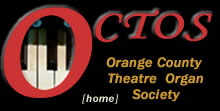
 |
 |
 |
 |
 |
 |
 |
-
The History of the Organ through 1993
In 1929, the Fullerton High School District started construction of a 1300 seat auditorium, later to be called Plummer Auditorium. At the same time, a "concert" configured organ was provided by the Wurlitzer Pipe Organ Company in 1929, about the time that demand for theatre instruments was waning due both to the depression and to the introduction of sound motion picture films. Up to that time, silent films were accompanied by pit orchestras, pianos, photoplayers or theatre organs. Wurlitzer was left with a large inventory of theatre pipe ranks and chestwork, which were used in the construction of the Plummer organ.
In 1930, the same year that the auditorium was dedicated, the debut concert on the organ was accomplished by Dr. Alexander Schreiner, the famous organist of the Mormon Tabernacle in Salt Lake City, Utah.The organ then had four 61-note keyboards, a 32-note pedalboard, 150 stopkeys, four swell pedals, one crescendo pedal, 28 ranks of pipes, a chrysoglott and a set of chimes. The pipes and percussion instruments were located in three chambers. Each pipe and instrument hammer was controlled by an individual magnet, so there was, as a result, a need for an elaborate switching system (called a "relay"). To our knowledge, the Plummer Organ had the only remaining example of a "remote capture action" built by Wurlitzer. The concept was that the organist could quickly and easily modify which stops were changed in response to pressing a piston while sitting at the organ. All other Wurlitzer organ combination actions could not "capture"; i.e., the selected stops had to be programmed by means of setting a series of small switches located inside the back of the console. This style is called a "setterboard" action. It is not known whether the Plummer remote capture action ever was fully operational. It was realized, however, that it was extremely rare, and so it was carefully disassembled and shipped to Barrington, Illinois, where it will be displayed in a music museum being constructed by Jasper Sanfilippo (owner of the largest theater pipe organ in the world). The original “concert” configuration and the limited number of stopkeys on the console made it difficult for the organist to play a broad range of literature. But it nevertheless basically was a very good quality instrument with some very nice theater ranks of pipes along with some ultra-soft "classic" ranks. Because of the limitations, the organ was rarely used and then played only for such events as commencements, an occasional concert, and organ classes offered by the high school and Fullerton College located across the street.
When Plummer Auditorium was used by the Fullerton Light Opera Association for stage presentations, live orchestras were employed rather than the pipe organ, which still is the arrangement to this day. Since the French-style console was located at the left end of the orchestra pit and featured French caps which extended above the stage level, they caused an unnamed member of the school board to bitterly complain that they obstructed her sight-line of the stage, so they were unceremoniously sawed off and replaced with 1/4" plywood and a new top. The original elaborate music rack was scrapped and replaced with a dinky electronic spinet organ rack. Even the scrollwork located beneath, and to the left and right of the manuals, was butchered.

[Home] [History] [Performances] [Performers] [Plummer Auditorium] [Events] [Links] [Contact]
Copyright© 2004
and beyond OCTOS.ORG. All Rights Reserved
Site maintained by OCTOS